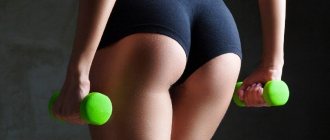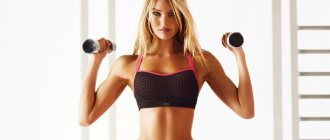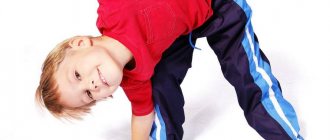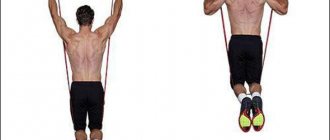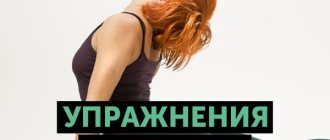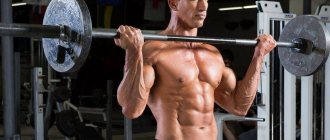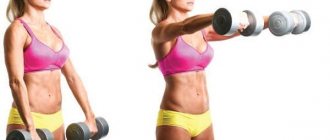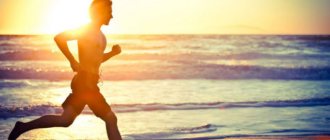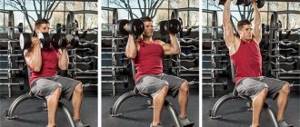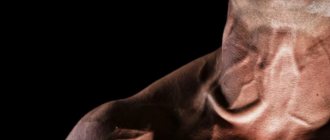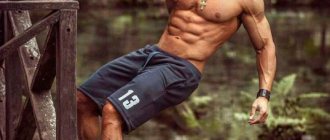The word “scoliosis” itself is translated from Greek as “crooked,” from which one can easily conclude that the condition characterizes changes in the physiological location of the spinal ridge. It is possible to prevent and cure the disease in the early stages; special exercises for spinal scoliosis, which can be easily performed at home, will help with this.
The pathology has several types and stages, and is more typical for children or adolescents: it is during the period of active growth that they are subject to serious stress: wearing heavy backpacks with textbooks, active sports, sitting at a desk for a long time. However, in recent years, the diagnosis is often found in adults who are forced to spend their working day at the computer or driving a car.
Exercises in the gym for scoliosis
Scoliosis of the thoracic region can be isolated, or it can have a “continuation” in the lumbar region. In this case, we are talking about the thoracolumbar type of disease. Treatment for this disease is slightly different. In this part of the article we will focus on one arc of curvature.
- Let's start with diaphragmatic breathing. Inhale, inflating your stomach. As you exhale, slowly release the air. At the same time, the volume of the abdominal cavity decreases. Such gymnastics not only regulates breathing. It strengthens the muscles of the back and abdominal wall, which maintain the vertical position of the spine. We continue physical therapy training of the press with “stepped” exhalation. The inhalation is uniform, and the exhalation is gradual with tension in the rectus abdominis muscles;
- Gymnastics continues in the prone position.
It is necessary to lift the thoracic spine upward. Hands follow the body. Therapeutic gymnastics is performed in 8 approaches:
- The boat exercise has all the limitations described above. It is not included in the complex in case of severe pathology of the lumbar region. However, it is indicated for isolated thoracic scoliosis. In any case, before any classes, consultation with a physical therapy instructor or attending physician is necessary. While lying on your stomach, lift your outstretched arms and legs up. Hold the pose for 10-15 seconds. Perform 3-4 approaches until the muscles are completely tired. Charge treatment is effective only at full load;
- Torsion of the spine in the thoracic region. We perform this complex in the knee-elbow position. The right leg is pulled back, the left hand goes down under the supporting hand. Repeat 10 times and change sides. After this, we again stand on our knees. The therapeutic exercise continues with twisting backwards. We move our hand to the lower back 10 times. We repeat a similar movement on the other side.
We finish the complex by strengthening the muscles that pull the curved arc in the opposite direction. To do this, you will need a roller 15-20 cm high made of soft material. You need to lie on it with the side on which there is a pathological arch. For right-sided scoliosis of the spine, we lie on the right side.
A common cause of lateral curvature of the spine is uneven development of the back muscles. To correct this, you need to perform symmetrical strength exercises.
Many usual exercises cannot be done with scoliosis. For example, elements that create compression loads and promote twisting of the spine are prohibited:
- squats;
- deadlift;
- pull-ups on the horizontal bar;
- bending over with a barbell on your shoulders;
- military press.
We offer an example of a safe training plan for uniformly strengthening the back muscles:
- Warm-up: 5-7 minutes of calm walking on an elliptical trainer.
- Pull-ups in the gravitron (or pull-down of the upper block): 3x20.
- Chest row on the lower block while sitting: 3x20.
- Bent-over rows with a rubber expander: 3x20.
- Hyperextensions: 3x20.
- Pullover in a crossover with a straight neck: 3x20.
- Forearm plank: 3 sets of 20-30 seconds.
Select the weight in the exercises so as not to feel failure on the last repetitions. Your task is not to build a powerful back, but to strengthen the muscles. If you feel pain in your spine while performing an element, refuse it and inform your coach. Rest between sets until complete recovery.
Come to the clinic for examination every month. The doctor will evaluate the results of the training and give recommendations on the selection of loads.
Contraindications
Therapeutic gymnastics in some cases may be contraindicated in whole or in part, until the risk factors for complications are eliminated. Some patients can perform exercises only in a physical therapy room, under the supervision of a specialist. All this is determined by the attending physician during the examination, but it is impossible to independently assess the health risks.
Some patients should exercise under the supervision of a physical therapy doctor
The main contraindications for prescribing exercise therapy are:
- scoliosis 4 degrees;
- accelerated progression of the disease;
- serious dysfunction of the cardiac or respiratory system;
- high intracranial pressure.
Scoliosis 4 degrees
Reasons for temporarily stopping classes:
- exacerbation of chronic diseases;
- infectious and colds accompanied by high fever;
- postoperative period;
- increased pain in the spine after physical activity.
If you experience severe pain, stop training temporarily.
Exercises should not be performed until the condition has stabilized, so as not to provoke deterioration. If pain or discomfort is related to your back, be sure to tell your doctor and do not try to solve the problem on your own. The spine contains many nerve endings that are often pinched due to deformation of the vertebrae. When examined in a clinic, it is easy to identify problem areas and eliminate the cause of pain, but this is unlikely to be done at home. And the more neglected the condition, the more difficult it will be to cope with it.
Hypertensive patients, heart patients, and patients with chronic gastrointestinal diseases should practice under the supervision of a doctor. The same applies to pregnant women over 3 months of age: at home it is difficult to control the distribution of the load, so it is better to practice in a physical therapy room with an experienced specialist.
Main signs of the disease
Deformations caused by the disease are hidden by clothing and movements and are practically invisible in everyday life. In most cases, the diagnosis of the disease occurs as a result of certain standard examinations, which are aimed at identifying its symptoms.
During inspections, pay attention to the following signs:
- waist triangles are the space between the waist and the arm in a position where the arms hang freely along the body; with second-degree scoliosis they will not be symmetrical;
- with this disease, the level of the shoulder blades and shoulders relative to the floor is noticeably different;
- twisting of the spinal column around its axis;
- asymmetry of the gluteal folds.
Symptoms of second-degree scoliosis can appear in a variety of combinations, but a doctor with good experience will certainly note them. The most accurate method for determining the disease is radiography.
You can perform test slopes yourself. This method is mentioned in almost all materials on the study and diagnosis of the disease. The patient who wants to use this method performs smooth forward bends. When bending, it is necessary to alternately round the cervical spine, then the thoracic and lumbar spine.
It is necessary to monitor the symmetry of both halves of the body
Particular attention is paid to the line that is drawn tangentially to the extensor muscles located in the lumbar spine, as well as in the thoracic region, behind the ribs. While performing this test, you may notice that on one side the ribs will protrude more
In the lumbar region, the muscles stand out a little more on one side than on the other.
Scoliosis of the second degree can be fixed or unfixed. Unfixed differs in that the curvature increases under load. This fact can only be revealed by taking x-rays, which must be taken in a lying and standing position. In the photographs in a standing position there is a slightly larger angle of curvature.
Set of exercises
Let's look at a number of exercises for scoliosis, which we divided in stages.
- Stand against the wall so that your heels, shins, buttocks, shoulder blades, and the back of your head touch it. In this position, your spine is perfectly aligned vertically. Fix it in this state and move away from the wall.
- In a standing position, with your legs slightly apart, raise your arms straight up and move them back out to your sides. Repeat the rotations.
- Walk in place, slightly raising your knees, while inhaling, raise your straight arms up, and as you exhale, lower them.
The set of basic exercises depends on the type and stage of scoliosis and is selected individually. Let's look at the main ones.
For thoracic C-shaped scoliosis:
- Lying on your back, pull your leg bent at the knee towards your chin while rounding your back. Perform with the second leg.
- Lie on your back, bend your knees. Raise your pelvis and body so that only your feet, shoulders and shoulder blades touch the floor. Hold on, perform 4-5 more times.
- In a position on your stomach, rise on your hands so that the upper part of the body is above the floor, and a deflection forms in the place of curvature. Hold yourself, then lie on the floor with your arms along your body and relax. Do 4-5 approaches.
For lumbar scoliosis
- In a supine position, place your arms behind your head, place your palms on the back of your head, and do 4-5 lifts of the body to the area of curvature.
- Lying on your back, raise your straight legs to an angle of 30 degrees. Rotate your legs to imitate riding a bicycle.
- Take a position on your side so that the outer side of the arc of curvature is facing up. Place your hand under your head and your other hand in front of your body. Raise your straight legs to an angle of 30 degrees, hold for a few seconds, and lower.
- Extend your arm up from the inside of the arch of the spine. Lower your arm, then move your leg to the side on the side of the convex curvature. Combine arm and leg raises, alternating sides.
Since scoliosis is characterized by the formation of an arch, exercises are required to load the area on the outside of the curvature.
- Lie on your back, make a bend in the thoracic region, stretch the arm that is on the inside of the arch forward.
- In a standing position, move your arm back from the outside of the bend, raise your other arm up.
- Lie on your side on the inside side of the arch, perform body raises.
- Raise your outstretched arm from the side of the inner arch, lower your other arm, stretch your arms, trying to align your spine.
- Exercise “Walking in place,” but with the transition to your toes while raising your arms up while inhaling.
- Walking in place with high knees.
At the initial stage, all exercises are performed until fatigue. You should not overload your body. Over time, you need to increase the number of approaches. If you feel pain during any exercise, stop doing it.
Symptoms of kyphoscoliosis: how to identify the disease
At the first stage, symptoms are barely noticeable. Patients usually associate minor pain, a feeling of heaviness and shortness of breath with fatigue, the onset of heart disease, and physical overload. This is the main problem that kyphoscoliosis is usually detected already in the progression stage.
Main signs of the disease:
- the formation of small “humps” on the surface of the back;
- stooping, poor posture;
- the appearance of back pain (in the initial stages the discomfort is insignificant, over time its intensity increases);
- acquisition of sloping shoulders, roundness of the back;
- the occurrence of shortness of breath (minor at the beginning of the disease and pronounced in the last stages);
- impaired sensitivity in the limbs, the appearance of temporary paresthesia;
- deformation of the sternum, weakness of the abdominal muscles, protrusion of the abdomen.
When the curvature of the spine reaches impressive levels, the deformation leads to the appearance of many neurological disorders, damage to the lung tissue, and the appearance of heart disease.
Kyphoscoliosis is a combination of lateral and anteroposterior curvature
Patients may experience:
- difficulty breathing, especially difficult to inhale;
- heartache;
- indigestion, heartburn, belching;
- pain, tingling in the limbs, temporary paralysis;
- sexual function disorder;
- headache, sudden attacks of dizziness.
Types of exercise therapy loads
Scoliosis is characterized by changes in the muscle corset due to curvature. Since in scoliosis the spine forms an arch, the muscles on its outer side are extremely stretched and tense.
On the inside of the arch, the muscles are pinched, spasmed and become atrophied over time. Therefore, during exercise therapy classes, various types of loads are used:
- exercises are performed alternately on only one side, while the opposite side is relaxed;
- an even load on the muscles on both sides, which is necessary for straightening the spine;
- alternating the load on different muscle groups to avoid overstraining some and undertraining others;
- General strengthening exercises to keep the whole body in good shape. During such exercise therapy exercises, the abs, arms, legs, and buttocks are involved.
Rules for conducting exercise therapy for scoliosis
For physical therapy to be effective, we recommend adhering to the following rules and tips:
- Exercises should only create passive stretch in the spine. Straining under strain can worsen the condition.
- Classes should be conducted regularly. If there are no contraindications from your doctor, it is best to train every day.
- Before starting class, you need to warm up. A good warm-up will help prepare muscle fibers for stress and improve their responsiveness to training.
- You should start gymnastics with simple elements. Gradually move on to more complex exercises. This will avoid injury and improve training efficiency.
- All elements of the gymnastic complex must be performed with your own body weight at a slow pace. It is unacceptable to create compression and shock loads on the spine.
- A set of exercises for scoliosis should contain elements that involve all the muscles of the body. This will improve your overall physical condition and speed up your recovery.
Prohibited exercises
With scoliosis, not all exercises and work with the muscular corset can be beneficial. Some actions can lead to serious complications and speed up the deformation process. Therefore, independent inclusion in a set of approaches without consultation with a specialist is not recommended. The following activities are contraindicated for any curvature of the spine:
- Oriental martial arts or martial arts.
- Any sagging on the horizontal bar or attempts to pull yourself up on it.
- Running, including on a treadmill or light in the park.
- Somersaults (especially dangerous when there is a curvature in the cervical spine).
- Football, volleyball, basketball classes.
- Any elements of acrobatics.
- Quick exercises, dynamic exercises.
- Any strength exercises, working with dumbbells or barbells.
- Stay in the lotus position for a long time.
- Torso rotation in a vertical position.
- Exercises aimed at one side, since asymmetrical loads significantly worsen the condition.
- Plank (except for the initial stages, if there is no prohibition from the doctor).
- Squats with weights.
- Dancing and gymnastic elements due to high load.
Some sports can place unwanted stress on the spine, causing injuries or sprains. In addition to those listed, these also include fencing, tennis, boxing; in most cases, they load only one side of the body and provoke severe curvature. You can replace them with swimming, yoga, Pilates, Nordic walking or skiing.
Prohibited activities can cause irreparable harm to the body in the presence of scoliosis, and therefore are completely excluded for the patient. At a severe stage of development of the deformation process, exercises are performed only within the framework of the complex recommended by the doctor.
Degree of disease development
Kyphoscoliosis has four degrees, they are divided depending on the degree of deformation of the spine and the angle of its curvature. The clinical picture of the disease will change with the progression of the pathology.
Classification of kyphoscoliosis
- First degree. This stage is characterized by a slight displacement of the vertebrae with slight twisting, the angle of curvature is up to 55. No noticeable deviations of the spinal axis have yet formed.
- The second degree is a more pronounced deviation of the spine with more pronounced twisting, the angle of curvature of the spine is up to 65. The patient suffers from shortness of breath, which is accompanied by spinal pain.
- At the third degree, irreversible processes begin. The chest is noticeably deformed, the rib hump becomes visible with a spinal curvature angle of up to 75°. Against this background, shortness of breath increases and pain in the heart appears.
- And the fourth degree is the most difficult form of pathology to treat, when deformation processes simultaneously affected the chest, spinal column and pelvis. A hump is formed in front and behind, with a spinal curvature angle of 75°. The person experiences severe pain, which is accompanied by periodic numbness of the limbs.
Degrees of development of kyphoskyphosis
The spine can be curved to the left or right side, depending on this, the pathology will be called right- or left-sided.
What is scoliosis
A distinctive sign of the disease is curvature of the spine in the lateral planes. Frequent accompanying symptoms:
- pain;
- increased fatigue;
- uneven muscle development;
- twisting of the vertebrae.
The danger of scoliosis lies not only in the aesthetic imperfection of the figure. Pathology negatively affects internal organs. For example, over time, progressive scoliosis leads to deformation of the chest, which causes overstrain of the heart muscle and breathing problems.
Scoliosis refers to the lateral curvature of the spinal column. It can be one-sided (when the spine forms a small arc in the frontal projection), multilateral - 2 or more bends. Visually, this is accompanied by back asymmetry (one shoulder blade is higher than the other).
The disease is classified into three types:
- C-shaped. Characterized by one lateral curvature.
- S-shaped. Represents two curvatures to the right and left.
- Z-shaped. Has three arcs of curvature.
Doctors often use another classification when determining the severity of scoliosis:
- 1st degree (deformation up to 10°). Subtle curvature. Features: slight asymmetry of the scapular bones.
- 2nd degree (deformation from 11 to 25°). Noticeable curvature. Features: pronounced asymmetry of the shoulder girdle.
- 3rd degree (deformation from 26 to 50°). Severe curvature. Features: back pain, disruption of internal organs.
- 4th degree (deformation more than 50°). Critical curvature. Features: formation of a one-sided hump, regular severe pain, disruption of the functioning of internal organs.
Readers who are far from medicine often confuse the concepts of “scoliosis” and “kyphosis.” These are different pathologies. The first is characterized by a lateral curvature, the second by a backward deformation of the upper spine.
The distinctive signs of kyphosis are:
- slouch;
- narrowing of the chest;
- weakness of the back muscles;
- appearance of a hump.
Associated symptoms:
- change in the shape of the vertebrae;
- compression of internal organs;
- spinal hernia;
- painful sensations.
Since diseases have their own signs and symptoms, this means that approaches to therapy must be different. Physical therapy should also be selected individually, depending on the severity of the pathology.
Only a doctor can accurately determine the nature of the curvature and make a diagnosis. If you notice any of these symptoms, contact the clinic immediately. Self-treatment for any deformities is contraindicated.
Corseting as an effective remedy
Abbott-Chenault once made a big step forward in the fight against scoliosis. He developed a special corset that prevents the disease from progressing and straightens the patient's back. To achieve the effect, the corset must be worn every day for 10-16 hours. The patient can remove it during sleep or gymnastic procedures.
Therapeutic corset for posture correction
The operating principle of this invention is very simple. Such a corset is created individually for each patient. It is modeled from a cast made of a person’s torso, taking into account all the features of the body and disorders of the spine. Such a corset constantly compresses the spine in a vice, straightening it and forcing it to remain in an upright position. This not only prevents the disease from progressing, but also straightens the patient’s back very well.
A corrective corset is usually used for spinal curvature of 20° or more. This method of treatment has one big drawback. This method is applicable mainly to children and adolescents, since only a young body can correct with the help of a corset. Applying adjustments for adults will produce less impressive results. Moreover, this will create a lot of inconveniences that are not worth the resulting effect.
Muscle strengthening exercises
- Lie on your stomach, stretch your arms forward.
- Raise your right arm and left leg at the same time.
- Breathe evenly and maintain the position for five breathing cycles.
- Repeat the exercise by raising your left arm and right leg.
There is another variation of this exercise:
- Lie on your stomach, stretch your arms forward.
- Place your palms on a raised surface about 20 centimeters or, if you have sufficient shoulder mobility, on the seat of a chair.
- Pressing your palms into the raised area, lift your body off the floor so that your palms are at shoulder level.
- Hold the pose for five breaths and lower down.
- Repeat several times.
- Lie on your back, stretch your arms above your head.
- Raise your straight legs to 90 degrees and hold this position for five seconds.
- Lower your legs to 60 degrees and hold this position for five seconds.
- Lower your legs to 30 degrees and hold again for five seconds or as long as you can.
- Make sure your lower back does not lift off the floor. If you can't hold it, just lower your legs down as slowly as possible without hesitation.
This pose also helps strengthen the rectus abdominis muscle.
- Lie on your back.
- Lift your upper back and legs off the floor. The lower back is pressed to the floor.
- Extend your arms straight along your body until they are parallel to the floor.
- The toes are at eye level.
- Hold the pose for 30 seconds.
One new study, Serial Case Reporting Yoga for Idiopathic and Degenerative Scoliosis, confirms the effectiveness of side planks for correcting scoliosis in adolescents and adults. Dr. Fishman and colleagues tested the effectiveness of the side plank on 25 participants - people from 14 to 85 years old with idiopathic scoliosis (of unknown origin). The researchers first checked each participant's posture using x-rays, then explained how to do a side plank and asked them to hold the pose for 10 to 20 seconds each day.
Because scoliosis is an asymmetrical position, Dr. Fishman decided to treat it asymmetrically by asking patients to perform the pose only on the weaker side.
On average, patients performed side planks for 1.5 minutes a day, six days a week for six months. Among 19 patients who performed the pose three times a week, the condition of the spine improved by 40.9%. In adolescents, the curvature was corrected by an average of 49.6%, in adults - by 38.4%.
Here's how to do a side plank:
- Stand in a lying position, shoulders over wrists, body extended in a straight line.
- Raise one arm off the floor, turn your body so that your chest faces to the side, and extend your arm up above you.
- If you have a curvature of the spine to the right side, perform the plank using your right hand.
- Hold the pose for 10–30 seconds. Every day, try to stay in the plank a little longer.
This exercise helps you relax after a short workout.
- Lie on your back with a folded towel under your knees and something under your head to keep your neck in a neutral position.
- Close your eyes and completely relax.
- Breathe deeply and calmly, try to feel the tension leaving your body.
- Relax for five minutes.
- After this, stand up smoothly and carefully.
Do these exercises three to four times a week to improve your flexibility and posture.
Scoliosis is a postural disorder in which a lateral curvature of the spine occurs in the shape of the letter C or S. This disease of the musculoskeletal system introduces significant disharmony into a person’s appearance, and over time can have a negative effect on internal organs (heart, lungs, stomach). The use of exercise therapy as part of the treatment of scoliosis allows you to completely eliminate the problem in the early stages, and in advanced stages 3 and 4, exercises become an integral part of the treatment complex.
Content
From this article you will learn what the rules are for performing exercise therapy for scoliosis and what exercises it includes. Following the recommendations listed above will help eliminate the problem with the spine or obtain reliable prevention.
Physiotherapy
To strengthen the back muscles that support the spine, make it a habit to do exercises every day and very soon they will become your good habit, without which it will be impossible to start a new day.
Exercise swallow
First, do the well-known “scissors”, “bicycle” and “swallow” exercises every day. Do the first two as much as your physical fitness allows, and stand in the swallow pose for ten seconds at least once in one session.
The set of exercises that we propose to learn and perform daily is aimed at strengthening muscles. At first, perform each exercise as many times as you can, increasing the number of repetitions over time to ten.
Stand with your back to the wall, try to straighten up as much as possible. Start “sliding” down the wall until your knee angle reaches ninety degrees. Stay in this position for a few seconds and slowly straighten up as well.
Stay in a half-squat position for a few seconds
- Move a little away from the wall. Place one foot on the heel and pull the toe towards you until you feel that the thigh muscles are very tense. Switch legs and do this exercise with the other one.
- Lie on your back on a hard surface. Legs extended. Raise your right leg, bend your knee and pull it towards your chest as much as possible. Straighten, lower to the floor. Repeat the exercise with your left leg.
- Remain on your back. Raise your legs, bend them at the knees and try to pull them towards your head. At the same time, also pull your head towards your knees.
- Get on your knees and, placing your hands on your heels, try to bend forward while maintaining the position of your hands.
Exercise kitty
- Get on all fours and start doing the “cat” exercise - alternately round, straighten and bend your back down.
- Standing on a flat surface, place your straightened right leg with your heel on a chair. Start bending your torso towards your leg. Then switch legs and perform the exercise with your left leg elevated.
- Get on your knees and lower your buttocks to your heels. Stretch your arms up and begin to bend forward, trying to touch your chest to the surface of the floor.
Stretch forward, trying to touch your chest to the floor
The final exercise is performed standing. Raise your arms up and bend your elbows at a ninety-degree angle. Move your bent arms back as far as you can. Return to the starting position.
Breathing exercises are mandatory for scoliosis
Treatment of second-degree scoliosis must be combined with breathing exercises. Specially designed exercises restore the respiratory function of the lungs and return ribs deformed by scoliosis to their normal physiological state.
Features of Katharina Schroth's technique
Shrot therapy
There are techniques developed specifically to eliminate the problem of scoliosis and relieve back pain. Only a medical specialist can select the optimal method for treating scoliosis based on the patient’s testimony.
Shrot therapy
Katharina Schroth has developed a method for treating scoliosis by selecting certain exercises aimed at eliminating improper breathing. Since a person suffering from scoliosis initially inhales and exhales incorrectly, exercises correct the breathing process.
Therapy is performed as follows:
- A physical therapist will guide the patient into the correct position, placing him against a wall or preparing him for some other type of warm-up.
- The patient performs the complex so that the inhalation is performed slowly and maximally.
- Exhale through the lips, which are compressed halfway, which will reduce the distance between the ribs.
- After completing a course of gymnastics, the patient is conscious of body position and inhalation and exhalation.
Lana Paley Method
Lana Paley has developed a unique complex for correcting the position of the ribs and back muscles. She described this complex in her book “Better than Yoga.” All exercises are performed within an hour.
Important: the main exercises consist of holding your breath while inhaling when the body is in a horizontal position and exhaling slowly, as well as creating the effect of elongation from a standing position.
If the complex is performed correctly, the result will be noticeable after two months of training.
Exercises for stage 2 deformity
Causes of scoliosis
The most common cause of scoliosis is poor posture. Incorrect posture, taken too often, gradually creates changes in the spinal column. As a result, the vertebrae take an unnatural position, shifting to the side, the spine gradually bends, and grade 1 thoracic scoliosis develops. Over time, the disease progresses, moving into subsequent, more severe forms.
Along with acquired scoliosis, congenital scoliosis occurs. In such cases, the cause of curvature of the spine may be extra ribs, vertebrae, wedge-shaped vertebrae, nonfusion of the arches, fusion of processes with arches, anomalies of the transverse processes, and others. Congenital cases of scoliosis account for 5% of all incidence cases.
- neurogenic scoliosis, which occurs against the background of neurological disorders causing muscle weakness (poliomyelitis, myopathy, spastic paralysis);
- static scoliosis that occurs against the background of disproportions of the lower extremities;
- idiopathic scoliosis (origin unclear).
— 1st degree: characterized by minor deviations;
— 2nd degree: curvature becomes noticeable, a rib hump begins to form;
— 3rd degree: irreversible, clearly defined destructive damage to the chest, a large costovertebral hump formed, severely limited mobility of the vertebrae.
— C-shaped (with one arc of curvature), most often observed with right-sided thoracic scoliosis;
— S-shaped (with two arcs of curvature);
— Z-shaped (with three arcs of curvature).
The disease in the overwhelming majority of cases occurs in childhood and adolescence and most often affects the thoracic region. And in childhood, scoliosis is completely cured, while in adulthood it is only possible to slow down the progression of the disease.
When the lumbosacral spine is affected, grade 1 left-sided scoliosis is usually diagnosed. This type of scoliosis is characterized by deformations that are invisible from the outside, which complicates the correct diagnosis. This type of scoliosis leads to constant back pain at a young age (20-30 years).
The first thing that becomes noticeable is the difference in the shoulders - the collarbones and shoulder girdles are located asymmetrically, at different levels. On the side of the lowered shoulder girdle, the position of the nipple is also reduced; the triangle of the waist on this side is noticeably deeper.
If during examination the ilia and knee joints are located symmetrically, pathological changes in the spine can be assumed.
The presence of disproportion in the iliac crests suggests deviations in the development of the hip joints or disproportion of the limbs.
- You cannot hang on the horizontal bar and do pull-ups on it.
- Somersaults are prohibited.
- Do not lift heavy objects (barbells).
- It is forbidden to make fast movements.
- You can't do martial arts.
- Running is also prohibited.
Here is a set of exercises for this stage:
- walking on all fours or with knees half bent in a circle;
- lying on your side, you need to raise your leg up;
- standing on all fours, bend over like a cat;
- lying on your stomach, hands clasped behind your head, try to rise and bend as far as possible.
Doctors recommend combining such exercises with wearing corsets, sleeping in plaster beds, and periodically visiting a massage therapist.
Gymnastics at home
Classes to eliminate spinal curvature are most often carried out at home. The important point is to exclude prohibited exercises and monitor the correctness of each approach. An ordinary mirror helps with this, or attracting a second person who will observe from the side. The whole complex consists of several stages:
- Warm up. These can be simple exercises aimed at warming up the muscles of the neck, back, chest and limbs. For this purpose, bends to the side, rotations, and circular movements of the shoulders are used. Effective warming up of the muscles directly affects the process of straightening the spine and allows you to prepare the muscles for the upcoming loads.
- Basic symmetrical exercises. Both with left- and right-sided curvature, the load is provided for the entire back as a whole. After all, it is impossible to eliminate the violation by directing force to only one side. Yoga approaches help well, for example, “Cat”, which involves bending and straightening the back on all fours, or “Embryo” pose. It involves stretching your back using your own weight.
- The final part of the training. It is somewhat reminiscent of the period of preparation for a lesson, and may include walking in place or rolling from toes to heels. An important task is to restore breathing and calm overheated muscles.
All proposed exercises are considered basic and therefore suitable for use by both adults and teenagers. If elements of stretching are involved, then a doctor’s consultation is required first, because some actions can do more harm than good. In general, stretching for scoliosis in the initial stages is not contraindicated.
Video Therapeutic exercises for scoliosis
Scoliosis 2 degrees is a disease that involves curvature of the spine and its deviation to the left or right from the vertical axis by 10-27°. This back deformity is very noticeable and immediately noticeable, so treatment should be started as quickly as possible. Special exercises for grade 2 scoliosis will help with this. There are basic and additional methods of combating the disease. The main ones involve certain methods of influencing the back.
- Lana Paley gymnastics. This set of exercises will strengthen your back muscles and correct the spine itself. The complex also includes breathing exercises by Lana Paley, which is designed to correct the position of the ribs and chest. After all, quite often they become the root cause of scoliosis.
- Katharina Schroth method - breathing exercises.
- Abbott-Chenault corset, which corrects posture.
Auxiliary treatment methods are not mandatory, but they can help the patient in the fight against grade 2 scoliosis. These include swimming, massage, manual therapy, and the use of special insoles.
Types and degrees of scoliosis
Exercises to correct scoliosis are always selected only by a doctor, since not all of them have a therapeutic effect for this diagnosis, and some exercises can aggravate the patient’s condition. An important condition is a correct diagnosis - the type and degree of curvature of the spine, which also influences the choice of activities.
Based on this, spinal scoliosis is divided into:
- forms of curvature: C, S or Z, which can be determined by carefully looking at the back of a standing patient;
- degree of disease, determined from the angle of curvature of the ridge arches:
| Degree | Cobb angle |
| 1st degree | 1-10 degrees |
| 2nd degree | 11-25 degrees |
| 3rd degree | 26-50 degrees |
| 4th degree | over 50 degrees |
Take into account the age of the patient - for elderly people, classes should be less intense and longer, taking into account the patient’s mobility and concomitant diseases.
What are the harms of second degree scoliosis?
When this disease is detected in a child aged 8-10 years, it can be assumed that the deformity is progressive. As the spine grows, the deformity intensifies. At the same time, the spine loses its characteristic flexibility for this age, so the situation is not easy to correct.
A curved spine is only part of the problem. Following this, changes begin in the chest. The ribs bend, which often leads to the formation of a rib hump. Since scoliosis affects not only the spine, but also the chest, breathing difficulties may begin.
However, the situation is less tragic when the disease is diagnosed at an older age. For example, if scoliosis is detected in young people over eighteen years of age, we can assume that there is no need to fear a noticeable increase in spinal deformity.
At this age, growth is almost complete and the spinal column has stabilized.
What exercises are harmful?
The back complex is a fairly effective method, but some contraindications must be taken into account.
These exercises are not recommended if you have scoliosis:
- Hanging on the bars.
- Acrobatic elements - somersaults, swallows and jumps.
- Strength training with kettlebells and dumbbells.
- Fast run.
- Various jumps.
- Torso rotations in the vertical direction.
Training is equally beneficial for men and women. Do not forget about regular exercise for a straight back and any violations will be corrected over time. See you soon, friends!
Prevention
To prevent the development of kyphoscoloiosis, you must adhere to the following recommendations:
- Eat properly. The diet should include all the vitamins and minerals necessary for the proper functioning and development of the skeletal system.
- Exercise. If kyphoscoliosis is present, a set of exercises should be selected only by a physical therapy instructor. Swimming and spinal stretching exercises are useful.
- Set up a place to sleep. You need to rest on a hard bed. It is best to choose an orthopedic mattress. It is recommended to sleep on your back. Resting on your side will make the curve worse.
- Organize a comfortable workplace. With a properly equipped work area, it is possible to maintain posture. In addition, you should not sit at the table for a long time. From time to time it is necessary to do a short warm-up.
Swimming is beneficial for kyphoscoliosis.
Kyphoscoliosis is a severe and painful pathology.
In order not to encounter it in adulthood, it is recommended to monitor your posture even in childhood and pay attention to the first signs of stooping. And the most important thing is not to let the disease get worse!
- Diseases starting with the letter A - vitamin deficiency
- angina
- anemia
- appendicitis
- arterial pressure
- arthrosis
- Graves' disease
- varicose veins
- gardnerellosis
- dermatitis
- cholelithiasis
- candidiasis
- leukoplakia
- mastopathy
- runny nose
- oliguria
- gout
- lungs' cancer
- salmonellosis
- tonsillitis
- ureaplasmosis
- pharyngitis
chlamydia
cervicitis
_
- lump on foot
- eczema
- Blood analysis
- Analysis of urine
- Pain, numbness, injury, swelling
- Letter A
Allergy - Letter B
- Letter G
- Letter K
- IN
- D
- Advances in medicine
- Z
- Eye diseases
- Gastrointestinal diseases
- Diseases of the genitourinary system
Genitourinary system - Respiratory diseases
Cough - Diseases during pregnancy
- Diseases of the heart and circulatory system
- Diseases in children
- Women's health
- Men's health
- Interesting Facts
- Infectious diseases
- Skin diseases
- beauty
- L
- Medicinal plants
- ENT diseases
- M
- Neurology
- Medical news
- P
- Parasites and humans
- R Miscellaneous_1
- Cancer
Miscellaneous_2
➤
The final part of the exercises
In this part you need to restore your breathing and measure your pulse. You can finish the complex with slow walking. A very good final exercise would be rolling. First you need to sit on the mat, bend your legs, and wrap your arms around it. Lying on your back, roll from side to side. You need to complete 8 approaches. This is a kind of massage for the ligaments and muscles of the spine. After stretching and warming up, the following exercise would be appropriate: standing on the mat, clasp your hands behind your back. Walking on your heels or on a special exercise machine will be very useful. Then walking on your heels changes to walking on your toes. Each exercise lasts up to 30 seconds.
After physical therapy exercises, it is advisable to rest. This can be done outdoors. There is no substitute for a few minutes of being outside. Fresh air will help restore strength and resume breathing.
The effectiveness of exercise depends on the intensity of the exercises. It is advisable to perform them every day for those whose degree of curvature has reached a critical point. Remember, your health is in your hands!
The spine is our main vital frame. Spinal diseases affect many organs, heart, and nerves.
Exercises for spinal scoliosis at home are simple and easy to remember. Don't be lazy and do them more often! Be healthy!
Diagnosis of the disease
With kyphoscoliosis, the patient experiences many symptoms that appear with heart disease and neurological disorders. Therefore, to make a correct diagnosis, it is necessary not only to confirm curvatures in the spinal column, but also to eliminate the risk of developing other pathologies.
Initially, the doctor will examine the patient’s back and find out all the complaints.
To diagnose kyphoscoliosis, the following measures are used:
- Clarification of complaints. The therapist carefully studies the symptom complex, the localization of pain, the time of onset of discomfort, its frequency and severity.
- Visual inspection by specialists. If a patient is suspected of having disorders in the spine, they are referred for consultation to a surgeon, orthopedist, or neurologist.
- Radiography. X-rays can detect spinal curvatures. Pictures are taken in different projections, sometimes during traction. Using X-rays, the volume of disorders in the spine is assessed, the angle of curvature is calculated, that is, the degree of pathology is determined.
- Magnetic resonance and computed tomography. These are more accurate and detailed research methods. Most often, MRI and CT are recommended to the patient in order to differentiate from tumor processes and other severe pathologies.
- Electrocardiogram. This event is prescribed to eliminate the risk of developing heart disease. In addition, an ECG makes it possible to evaluate disorders caused by compression of the chest.
- Ultrasonography. It is undertaken to study the internal tissues of the sternum.
- Lab tests. Such studies make it possible to suspect inflammatory, infectious causes of the development of the disease.
A fairly informative diagnostic method is radiography.
Why is scoliosis dangerous?
Scoliosis is manifested by different levels in the shoulders, asymmetry and irregularities. In later stages, deformities occur due to the curvature of the spine and an intercostal hump.
Scoliosis is also accompanied by pain that occurs during prolonged physical activity. Fatigue is also evident.
It is important to make adjustments to your normal day. Do not lift heavy objects or make sudden movements. With scoliosis, the spine may deviate to one side.
With curvatures in the thoracic region, there can be consequences in the form of displacement of organs, pinched nerves, metabolic problems and ailments of internal organs. Problems with the spinal column affect all systems of the body - from the genitourinary to the respiratory. If left undiagnosed, disorders in the spine can cause serious consequences.
